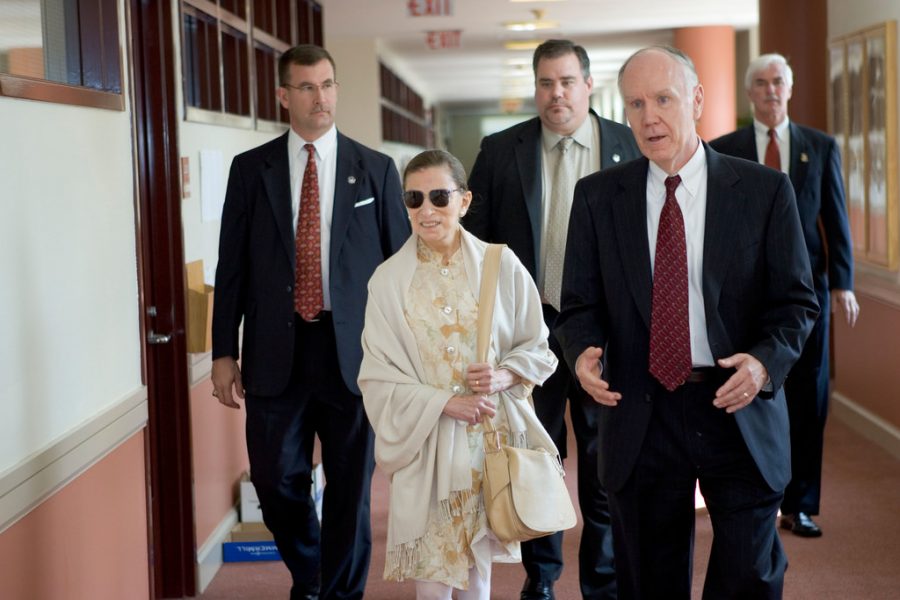Ruth Bader Ginsburg: A lifetime of defending gender equality
Visiting Wake Forest University School of Law, U.S. Supreme Court Justice Ruth Bader Ginsburg prepares to speak to law students in the Worrell Professional Center. Ginsburg’s influence as Associate Justice is widespread, earning her a spot such as one of Forbes’ 100 Most Powerful Women and a membership to the National Women’s Hall of Fame. The upcoming movie On the Basis of Sex about Ginsburg’s life and accomplishments will be released on Christmas day.
December 21, 2018
Ruth Bader Ginsburg has become a feminist icon in the world of politics and beyond with her groundbreaking work as Associate Justice of the U.S. Supreme Court. Regarded by many as the “Notorious R.B.G.,” Ginsburg is a dedicated and well-rounded figure who has made history in United States law and politics.
Born on March 15, 1933, Ruth Bader Ginsburg was raised in Brooklyn, New York in the midst of the Great Depression. She excelled as a student at James Madison High School. Unfortunately, her mother was unable to share this moment with her, as she died of cancer the night before. Four years later, she graduated at the top of her class at Cornell University in 1954. The same year, she married her husband, Martin Ginsburg, and had a child, Jane, before Martin was drafted to serve in the military. She also attended Harvard Law School, where she was one of nine female students in a class of about five hundred at the time. In 1957, Marty, as she called her husband, was diagnosed with testicular cancer. She then transferred to Columbia University, where she graduated first in her class. Ready to enter the workforce, Ginsburg began teaching civil procedure at Rutgers University in 1963 after being rejected by Felix Frankfurter, who was widely recognized as the first Supreme Court Justice to hire an African American clerk. After the birth of her second child, James, she was promoted to full professor. Then, she began working with the American Civil Liberties Union, which lead her to eventually heading the A.C.L.U. Women’s Rights Project. This allowed her to present several cases to the Supreme Court concerning the argument that discrimination on the basis of sex does in fact exist and that it is unconstitutional. In the midst of laws passed that permit men more protection by the law than women, this was only the beginning of Ginsburg’s fight towards a more feminist society.
One of her first major accomplishments in the courtroom was the recognition of a violation of the equal-protection clause in the Reed v. Reed case of 1971. Later, Ginsburg worked on another sex discrimination case in response to an unjust Air Force policy called Struck v. Secretary of Defense, which was eventually dismissed. However, Roe v. Wade later deemed anti-abortion laws, the subject of Ginsburg’s case, unconstitutional, though in terms of privacy rights as opposed to equal protection. Ginsburg went on to win Frontiero v. Richardson in 1973, which called out the unequal treatment of a female Air Force Lieutenant when she was denied benefits for her husband while men were given benefits for their wives.
In 1980, Ruth Bader Ginsburg was appointed to the United States Court of Appeals for the District of Columbia by Jimmy Carter. In 1993, President Bill Clinton appointed her to the Supreme Court.
In her time serving for the Supreme Court, Ruth Bader Ginsburg has made numerous historic rulings, causing her to be regarded as a political icon. Junior Nicol Sanchez is a big fan of Ginsburg and her many accomplishments: “I really look up to Ruth Bader Ginsburg. She has done so much for our country and for women, and I really admire her work.”
Fans of Ruth Bader Ginsburg can learn more about her life in the upcoming film On the Basis of Sex, starring Felicity Jones as Ginsburg. Directed by Mimi Leder, the film has already received excellent reviews from top critics. Be sure to see On the Basis of Sex in theaters on December 25.











